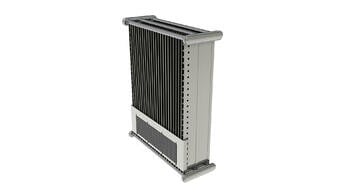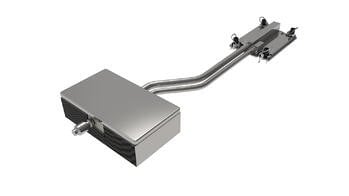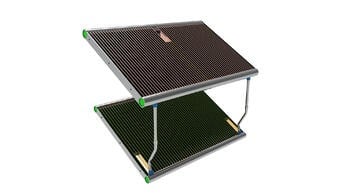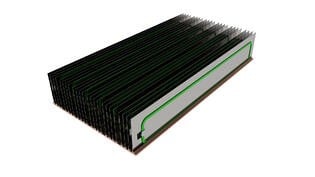이전 블로그에서 우리는 열사이펀의 기본 사항과 작동 방식을 살펴보았습니다. 모두 세 가지 기본 부품(증발기, 유체 루프 및 응축기)을 포함하는 수동 2상 시스템이지만 사용 방법에 따라 구성 방식이 다를 수 있습니다.
이 블로그에서는 Thermosiphon 구성 유형과 각각에 대한 몇 가지 일반적인 응용 프로그램을 검토합니다.
다른 열 사이펀 구성은 무엇입니까?
BOYD에서 열 사이펀은 일반적으로 네 가지 주요 범주로 나뉩니다.
3D 직접 접촉 루프 열 사이펀 :
- 일반적인 산업 및 응용 분야 : 산업 및 전기 통신(전력 인버터, 모터 드라이브, 5G 타워, 원격 무선 장치, MIMO 무선)
3D Direct Contact Loop Thermosiphons는 Thermosiphon 바닥에 직접 장착 된 하나 이상의 열원에서 열을 발산합니다. 이 열사이펀은 베이스와 핀에 증기 공급 및 액체 회수 튜브를 갖추고 있을 뿐만 아니라 부착된 핀의 전체 3D 부피를 통해 열을 분산시키는 매니폴드를 갖추고 있습니다.

작동 유체는 열을 흡수하고 열원에 가장 가까운 베이스의 튜브를 통해 흐르고 부력에서 위쪽으로 상승할 때 증기로 변합니다. 어셈블리의 상단과 하단을 감싸고 있는 매니폴드는 증기와 응축된 유체가 각 핀에 분배되도록 하여 일관된 냉각을 위한 등온 3D 구조를 보장합니다. 자연 또는 강제 공기는 근 등온 핀 어셈블리를 통해 흐르고 고효율로 주변 환경으로의 열을 거부합니다. 시스템에서 열이 거부됨에 따라 작동 유체는 핀의 튜브에서 재응축되어 중력에 의해 바닥의 액체 매니폴드로 되돌아가고 증발기로 돌아와 프로세스를 반복합니다.
직접 접촉 루프 열 사이펀 :
- 일반적인 산업 및 응용 분야 : 산업용 및 엔터프라이즈용(CPU, GPU, 인버터, 서버)
Thermosiphons의 가장 일반적인 유형 중 하나 인 Direct Contact Loop Thermosiphon Assemblies는 별도의 응축기 및 증발기 구성 요소를 특징으로하며, 이들은 간격을 두고 신중하게 배향 된 튜브로 연결됩니다. 증발기 베이스는 CPU 또는 GPU와 같은 열원에 직접 장착됩니다. 장치의 열은 증발기 내부에 고인 액체를 기화시켜 증기 튜브를 통해 원격 응축기 장치로 이동하게 합니다.

콘덴서에는 고밀도 핀 스택이 부착되어 있어 주변 강제 공기 흐름이 시스템에서 열을 제거합니다. 열이 제거되면 작동 유체가 재응축되어 리턴 튜브를 통해 증발기로 다시 흐릅니다.
Air-to-Air 루프 열사이펀:
- 일반적인 산업 및 응용 분야 : 통신, e모빌리티 및 산업용(캐비닛, 엣지 컴퓨팅, 5G 타워)
Air-to-Air Loop Thermosiphons는 다른 Air-to-Air 열교환기 유형과 유사하게 작동하지만 전도 또는 히트 파이프 대신 루프 Thermosiphon 기술을 사용하여 한 공기 흐름에서 다른 공기 흐름으로 열을 전달합니다. 증발기와 응축기 열교환기는 시스템의 절반은 인클로저 내부에, 나머지 절반은 인클로저 외부에 있는 튜브로 연결됩니다.

인클로저의 뜨거운 내부 공기는 증발기 코일의 유체를 증발시켜 증기 튜브를 통해 응축기 코일로 상승합니다. 강제 외부 공기는 응축기 코일을 통해 흐르고 작동 유체를 재응축한 다음 중력을 통해 리턴 튜브를 통해 프로세스가 반복되는 증발기 코일로 다시 흐릅니다.
2D 열 사이펀 핀 :

루프, 허니콤 또는 마이크로채널 설계로 제공되는 이러한 임베디드 열사이펀은 표준 알루미늄 핀의 성능을 크게 향상시킵니다. 2D Thermosiphon Fins는 열 성능을 최적화하여 무게를 줄이고 방열판 부피를 줄일 수 있으며 다른 기존 열 기술과 혼합하고 일치시킬 수 있기 때문에 일반적으로 사용됩니다.
이것들은 Boyd의 Thermosiphons에 대한 일반적인 범주이지만, 각각은 다양한 응용 분야에 맞게 사용자 정의 할 수 있습니다. Thermosiphons에 대해 궁금한 점이 있거나 다음 프로젝트에 이상적인 Thermosiphons에 대한 질문이 있는 경우 당사 웹사이트를 방문하거나 당사 전문가에게 문의하십시오.






